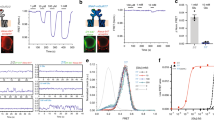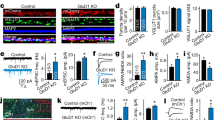Abstract
Synaptically released glutamate activates ionotropic and metabotropic receptors at central synapses. Metabotropic glutamate receptors (mGluRs) are thought to modulate membrane conductances through transduction cascades involving G proteins. Here we show, in CA3 pyramidal cells from rat hippocampus, that synaptic activation of type 1 mGluRs by mossy fiber stimulation evokes an excitatory postsynaptic response independent of G-protein function, while inhibiting an afterhyperpolarization current through a G-protein-coupled mechanism. Experiments using peptide activators and specific inhibitors identified a Src-family protein tyrosine kinase as a component of the G-protein-independent transduction pathway. These results represent the first functional evidence for a dual signaling mechanism associated with a heptahelical receptor such as mGluR1, in which intracellular transduction involves activation of either G proteins or tyrosine kinases.
This is a preview of subscription content, access via your institution
Access options
Subscribe to this journal
Receive 12 print issues and online access
$209.00 per year
only $17.42 per issue
Buy this article
- Purchase on Springer Link
- Instant access to full article PDF
Prices may be subject to local taxes which are calculated during checkout








Similar content being viewed by others
References
Sladeczek, F., Pin, J. P., Recasens, M., Bockaert, J. & Weiss, S. Glutamate stimulates inositol phosphate formation in striatal neurones. Nature 317, 717– 719 (1985).
Conn, P. J. & Pin, J. P. Pharmacology and functions of metabotropic glutamate receptors. Annu. Rev. Toxicol. 37, 205–237 (1997).
Anwyl, R. Metabotropic glutamate receptors: electrophysiological properties and role in plasticity. Brain Res. Rev. 29, 83– 120 (1999).
Lujan, R., Nusser, Z., Roberts, J. D., Shigemoto, R. & Somogyi, P. Perisynaptic location of metabotropic glutamate receptors mGluR1 and mGluR5 on dendrites and dendritic spines in the rat hippocampus. Eur. J. Neurosci. 8, 1488–1500 (1996).
Baude, A. et al. The metabotropic glutamate receptor (mGluR1α) is concentrated at perisynaptic membrane of neuronal subpopulations as detected by immunogold reaction. Neuron 11, 771– 787 (1993).
Shigemoto, R. et al. Differential presynaptic localization of metabotropic glutamate receptor subtypes in the rat hippocampus. J. Neurosci. 17, 7503–7522 (1997).
Hayashi, Y. et al. Role of a metabotropic glutamate receptor in synaptic modulation in the accessory olfactory bulb. Nature 366, 687–690 (1993).
Scanziani, M., Salin, P. A., Vogt, K. E., Malenka, R. C. & Nicoll, R. A. Use-dependent increases in glutamate concentration activate presynaptic metabotropic glutamate receptors. Nature 385, 630–634 ( 1997).
Charpak, S. & Gähwiler, B. H. Glutamate mediates a slow synaptic response in hippocampal slice cultures. Proc. R. Soc. Lond. B Biol. Sci. 243, 221–226 (1991).
Gerber, U., Lüthi, A. & Gähwiler, B. H. Inhibition of a slow synaptic response by a metabotropic glutamate receptor antagonist in hippocampal CA3 pyramidal cells. Proc. R. Soc. Lond. B Biol. Sci. 254, 169– 172 (1993).
Congar, P., Leinekugel, X., Ben-Ari, Y. & Crépel, V. A long-lasting calcium-activated nonselective cationic current is generated by synaptic stimulation or exogenous activation of group I metabotropic glutamate receptors in CA1 pyramidal neurons. J. Neurosci. 17 , 5366–5379 (1997).
Pozzo Miller, L. D., Petrozzino, J. J. & Connor, J. A. G protein-coupled receptors mediate a fast excitatory postsynaptic current in CA3 pyramidal neurons in hippocampal slices. J. Neurosci. 15, 8320–8330 (1995).
Hall, R. A., Premont, R. T. & Lefkowitz, R. J. Heptahelical receptor signaling: beyond the G-protein paradigm. J. Cell Biol. 145, 927– 932 (1999).
Kamiya, H., Shinozaki, H. & Yamamoto, C. Activation of metabotropic glutamate receptor type 2/3 suppresses transmission at rat hippocampal mossy fibre synapses. J. Physiol. (Lond.) 493, 447–455 (1996).
Pankratov, Y., Castro, E., Miras-Portugal, M. T. & Krishtal, O. A purinergic component of the excitatory postsynaptic current mediated by P2X receptors in the CA1 neurons of the rat hippocampus. Eur. J. Neurosci. 10, 3898–3902 (1998).
Jabaudon, D. et al. Inhibition of uptake unmasks rapid extracellular turnover of glutamate of nonvesicular origin. Proc. Natl. Acad. Sci. USA 96, 8733–8738 ( 1999).
Brabet, I., Mary, S., Bockaert, J. & Pin, J. P. Phenylglycine derivatives discriminate between mGluR1- and mGluR5-mediated responses. Neuropharmacology 34, 895–903 ( 1995).
Moroni, F. et al. Pharmacological characterization of 1-aminoindan-1,5-dicarboxylic acid, a potent mGluR1 antagonist. J. Pharmacol. Exp. Ther. 281, 721–729 (1997).
Gasparini, F. et al. 2-Methyl-6-(phenylethynyl)-pyridine (MPEP), a potent, selective and systemically active mGlu5 receptor antagonist. Neuropharmacology 38, 1493–1503 ( 1999).
Doherty, A. J., Palmer, M. J., Henley, J. M., Collingridge, G. L. & Jane, D. E. (RS)-2-chloro-5-hydroxyphenylglycine (CHPG) activates mGlu5, but not mGlu1, receptors expressed in CHO cells and potentiates NMDA responses in the hippocampus. Neuropharmacology 36, 265–267 ( 1997).
Winslow, J. W., Bradley, J. D., Smith, J. A. & Neer, E. J. Reactive sulfhydryl groups of α39, a guanine nucleotide-binding protein from brain. Location and function. J. Biol. Chem. 262 , 4501–4507 (1987).
Shapiro, M. S., Wollmuth, L. P. & Hille, B. Modulation of Ca2+ channels by PTX-sensitive G-proteins is blocked by N-ethylmaleimide in rat sympathetic neurons. J. Neurosci. 14, 7109–7116 (1994).
Dunwiddie, T. V. & Haas, H. L. Adenosine increases synaptic facilitation in the in vitro rat hippocampus: evidence for a presynaptic site of action. J. Physiol. (Lond.) 369, 365–377 (1985).
Trussell, L. O. & Jackson, M. B. Dependence of an adenosine-activated potassium current on a GTP-binding protein in mammalian central neurons. J. Neurosci. 7, 3306– 3316 (1987).
Eckstein, F., Cassel, D., Levkovitz, H., Lowe, M. & Selinger, Z. Guanosine 5′-O-(2-thiodiphosphate). An inhibitor of adenylate cyclase stimulation by guanine nucleotides and fluoride ions. J. Biol. Chem. 254, 9829– 9834 (1979).
Siciliano, J. C., Toutant, M., Derkinderen, P., Sasaki, T. & Girault, J. A. Differential regulation of proline-rich tyrosine kinase 2/cell adhesion kinase β (PYK2/CAKβ) and pp125(FAK) by glutamate and depolarization in rat hippocampus. J. Biol. Chem. 271, 28942–28946 ( 1996).
Peavy, R. D. & Conn, P. J. Phosphorylation of mitogen-activated protein kinase in cultured rat cortical glia by stimulation of metabotropic glutamate receptors. J. Neurochem. 71, 603 –612 (1998).
Boxall, A. R. & Lancaster, B. Tyrosine kinases and synaptic transmission. Eur. J. Neurosci. 10, 2– 7 (1998).
Hanke, J. H. et al. Discovery of a novel, potent, and Src family-selective tyrosine kinase inhibitor. Study of Lck- and FynT-dependent T cell activation. J. Biol. Chem. 271, 695–701 (1996).
Swarup, G., Speeg, K. V. J., Cohen, S. & Garbers, D. L. Phosphotyrosyl-protein phosphatase of TCRC-2 cells. J. Biol. Chem. 257, 7298–7301 ( 1982).
Liu, X. et al. Regulation of c-Src tyrosine kinase activity by the Src SH2 domain. Oncogene 8, 1119– 1126 (1993).
Vignes, M. & Collingridge, G. L. The synaptic activation of kainate receptors. Nature 388, 179– 182 (1997).
Castillo, P. E., Malenka, R. C. & Nicoll, R. A. Kainate receptors mediate a slow postsynaptic current in hippocampal CA3 neurons. Nature 388, 182–186 (1997).
Kehoe, J. Glutamate activates a K+ conductance increase in Aplysia neurons that appears to be independent of G proteins. Neuron 13, 691–702 (1994).
Guérineau, N. C., Bossu, J. L., Gähwiler, B. H. & Gerber, U. Activation of a nonselective cationic conductance by metabotropic glutamatergic and muscarinic agonists in CA3 pyramidal neurons of the rat hippocampus. J. Neurosci. 15, 4395–4407 (1995).
Zheng, F., Hasuo, H. & Gallagher, J. P. 1S,3R-ACPD-preferring inward current in rat dorsolateral septal neurons is mediated by a novel excitatory amino acid receptor. Neuropharmacology 34, 905–917 (1995).
Luttrell, L. M. et al. β-arrestin-dependent formation of β2 adrenergic receptor-Src protein kinase complexes. Science 283, 655–661 (1999).
Tu, J. C. et al. Coupling of mGluR/Homer and PSD-95 complexes by the shank family of postsynaptic density proteins. Neuron 23, 583–592 (1999).
Tu, J. C. et al. Homer binds a novel proline-rich motif and links group 1 metabotropic glutamate receptors with IP3 receptors. Neuron 21, 717–726 ( 1998).
Jonas, E. A. & Kaczmarek, L. K. Regulation of potassium channels by protein kinases. Curr. Opin. Neurobiol. 6, 318–323 (1996).
Wang, Y. T. & Salter, M. W. Regulation of NMDA receptors by tyrosine kinases and phosphatases. Nature 369, 233–235 (1994).
Lu, Y. M., Roder, J. C., Davidow, J. & Salter, M. W. Sr c activation in the induction of long-term potentiation in CA1 hippocampal neurons. Science 279, 1363– 1367 (1998).
Dale, T. C. Signal transduction by the Wnt family of ligands. Biochem. J. 329, 209–223 (1998).
Milne, J. L., Kim, J. Y. & Devreotes, P. N. Chemoattractant receptor signaling: G protein-dependent and -independent pathways. Adv. Second Messenger Phosphoprotein Res. 31, 83–104 ( 1997).
Marrero, M. B. et al. Direct stimulation of Jak/STAT pathway by the angiotensin II AT1 receptor. Nature 375, 247–250 (1995).
Mitchell, R. et al. Rhodopsin-family receptors associate with small G-proteins to activate phospholipase D. Nature 392, 411–414 (1998).
Eccles, J. C. & McGeer, P. L. Ionotropic and metabotropic neurotransmission. Trends Neurosci. 2, 39– 40 (1979).
Gähwiler, B. H., Thompson, S. M., McKinney, R. A., Debanne, D. & Robertson, R. T. in Culturing Nerve Cells (eds Banker, G. & Goslin, K.) 379–411 (MIT Press, Cambridge, Massachusetts, 1998).
Lancaster, B. & Rogers, M. V. A peptide activator of endogenous tyrosine kinase enhances synaptic currents mediated by NMDA receptors. Eur. J. Neurosci. 10, 2302–2308 (1998).
Trudel, S., Paquet, M. R. & Grinstein, S. Mechanism of vanadate-induced activation of tyrosine phosphorylation and of the respiratory burst in HL60 cells. Role of reduced oxygen metabolites. Biochem. J. 276, 611 –619 (1991).
Acknowledgements
We thank L. Heeb, L. Rietschin and R. Schöb for technical assistance, F. Pouille for the help with acute slices and D. Jabaudon, A. Lüthi, F. Loup, O. Raineteau and N. Arnth-Jensen for discussions and for reading the manuscript. We also thank N. Guérineau for initial experiments with tyrosine kinase inhibitors. Supported by Novartis (C.H.), the Prof. Dr. Max Cloëtta Foundation (U.G.) and a Swiss National Science Foundation grant 31-45547.95 (U.G.).
Author information
Authors and Affiliations
Corresponding author
Rights and permissions
About this article
Cite this article
Heuss, C., Scanziani, M., Gähwiler, B. et al. G-protein-independent signaling mediated by metabotropic glutamate receptors . Nat Neurosci 2, 1070–1077 (1999). https://doi.org/10.1038/15996
Received:
Accepted:
Issue Date:
DOI: https://doi.org/10.1038/15996
This article is cited by
-
Increased mGlu5 mRNA expression in BLA glutamate neurons facilitates resilience to the long-term effects of a single predator scent stress exposure
Brain Structure and Function (2021)
-
The dual face of glutamate: from a neurotoxin to a potential survival factor—metabolic implications in health and disease
Cellular and Molecular Life Sciences (2019)
-
Control of neuronal excitability by Group I metabotropic glutamate receptors
Biophysical Reviews (2017)
-
Synaptic ERK2 Phosphorylates and Regulates Metabotropic Glutamate Receptor 1 In Vitro and in Neurons
Molecular Neurobiology (2017)
-
Transduction of group I mGluR-mediated synaptic plasticity by β-arrestin2 signalling
Nature Communications (2016)



